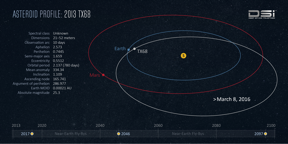Home > Press > TX68: Trash or Treasure? As asteroid TX68 nears its close approach on March 8, Dr. John Lewis, chief scientist at Deep Space Industries, discusses whether or not it’s a good mining prospect
 |
Abstract:
A small asteroid called 2013 TX68 is due to fly past Earth next Tuesday, March 8. And while TX68 poses no threat to our planet this time around — the latest NASA projection has the asteroid missing us by about three million miles, or 12.5 times farther away than the Moon — it is something of a curiosity to scientists and skywatchers alike.
TX68: Trash or Treasure? As asteroid TX68 nears its close approach on March 8, Dr. John Lewis, chief scientist at Deep Space Industries, discusses whether or not it’s a good mining prospect
Moffett Field, CA | Posted on March 3rd, 2016With the arrival of asteroid 2013 TX68 fast approaching, many people have been asking us: Is Deep Space Industries interested in mining it? Unfortunately, the answer is: We really can’t say.
As Dr. John S. Lewis, chief scientist at DSI and the man who literally wrote the book on asteroid mining explains, “One problem we have is that we know very little about this asteroid’s physical and chemical nature, so it is essentially a pig in a poke.” He adds that without knowing its spectral class and reflectivity, it would be nearly impossible for DSI to design the most effective mining and processing equipment to fit its circumstances.
While next week’s fly-by may offer planetary scientists with Earth-bound telescopes some idea of its composition, “Those data would arrive far too late to design, plan, fund, launch, and fly a mining mission to it this time around,” says Dr. Lewis. He points out that, “Maybe its chemistry will look interesting, maybe it won’t.”
However, the biggest problem with mining TX68, as Dr. Lewis sees it, is what we do know about it. We know that TX68 is in a typically eccentric orbit for near-Earth asteroids (NEAs). We know that it’s an Apollo asteroid — meaning that it is an Earth-crosser — which allows it to interact strongly with the three terrestrial planets: Venus, Earth, and Mars. And we know that TX68 is traveling at high speed when it crosses Earth’s orbit, making a rendezvous and mining mission extremely difficult and expensive.
“It’s also only about 100 feet (30 meters) in diameter, has an unknown rotation rate and pole orientation, and we know absolutely nothing about whether it is a dust pile, a sand bank, a gravel pit, a jumble of large hard-rock fragments, a stainless steel monolith, all of the above, or none of the above.”
And then there’s the matter of TX68’s lifespan. As an Apollo, and with its orbital plane so close to the plane of Earth’s orbit, it can be counted on to make many very close passes by all of the terrestrial planets. This gives TX68 a very short life expectancy on the cosmic scale — perhaps a million years or less — before it is destroyed in a collision with a planet.
“The bottom line is that it is a potential impact hazard to Earth, and a mission to characterize its physical properties and assess how serious a hazard it really is may eventually be required,” Dr. Lewis cautions. “But that’s a far cry from it being a profitable mining target.”
So, Dr. Lewis, does that mean DSI won’t ever mine TX68?
“‘Ever’ is a long time.”
####
For more information, please click here
Contacts:
Deep Space Industries
NASA Research Park
Building 156, Suite 204
Moffett Field, CA 94035
Meagan Crawford
Copyright © Deep Space Industries
If you have a comment, please Contact us.Issuers of news releases, not 7th Wave, Inc. or Nanotechnology Now, are solely responsible for the accuracy of the content.
| Related News Press |
|
|
||
|
|
||
| The latest news from around the world, FREE | ||
|
|
||
|
|
||
| Premium Products | ||
|
|
||
|
Only the news you want to read!
Learn More |
||
|
|
||
|
Full-service, expert consulting
Learn More |
||
|
|
||








